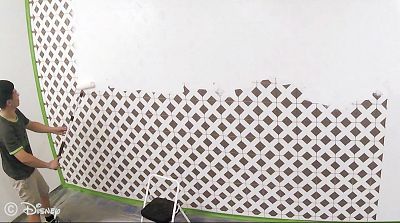Special paint offers a low-cost way to make intelligent surfaces.
Walls are great for separating rooms and helping support buildings and shelves, but they're useless when it comes to helping us control things within our homes and offices.
That could soon change. Experiments conducted recently at Carnegie Mellon University show that it's possible to transform ordinary walls into smart surfaces that respond to taps, swipes, and even gestures to control appliances, video games, and all manner of smart home devices.
A high-tech "Wall " smart wall looks just like an ordinary wall but can be used like a floor-to-ceiling trackpad.
"Users can control lighting or music play by double-tapping on walls or through swipe gestures," Yang Zhang, a Ph.D. student in the university's Human-Computer Interaction Institute and a member of the research team who conducted the experiments, told NBC News MACH in an email. "Similarly, users can also touch these walls to send commands to smart appliances such as TVs, Google Home, and Amazon Echo."
In addition, the walls can detect and respond intelligently to the activity of electrical appliances — for example, dimming the lights when a TV is switched on — and sense the presence of people in a room.
All that's needed to create a "Wall " surface is some electronic gear and conductive paint, according to the researchers. The total cost of materials is estimated to be $20 per square meter.
Zhang and the other members of the team, including researchers from Disney Research, created the smart walls using simple tools. They used painter's tape to create a crosshatch pattern, applied a couple of coats of conductive paint, and then removed the tape and attached electrodes.
Finally, they applied conventional paint to wind up with a surface that looks like any other wall — but which points to a new era of smart buildings that's been a long time coming. As Chris Harrison, an assistant professor in the institute and another member of the team, said in a written statement, "As the internet of things and ubiquitous computing become reality, it is tempting to think that walls can become active parts of our living and work environments."
Though the Wall fabrication process sounds simple, Zhang said that given the electronics involved it might not be the sort of thing you'd try as a DIY project — or even something a typical construction crew could easily handle. But he said the team hoped to work with commercial partners to make Wall commercially available.
Carlo Ratti, a professor of urban technologies at MIT and director of its SENSEable City Lab, welcomed Wall as another tool for interacting seamlessly with buildings and electronic devices. He called the technology "interesting," adding that "I see it as part of a growing portfolio of sensors that live with us in our homes and buildings."













